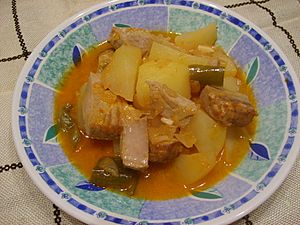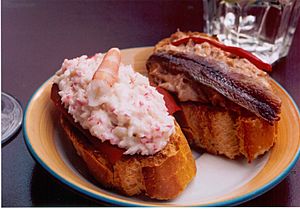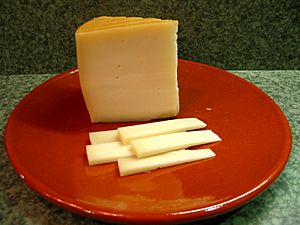Basque cuisine facts for kids

Basque cuisine is the delicious food from the Basque Country, a special region between France and Spain. It's famous for its fresh ingredients and unique cooking styles. You'll find yummy dishes like meats and fish grilled over hot coals, hearty stews such as marmitako (a tuna and potato stew) and lamb stews.
Other popular foods include cod dishes, special Tolosa beans, and paprikas from Lekeitio. A fun way to eat is with pintxos, which are small snacks similar to Spanish tapas. For dessert, there's Idiazabal sheep's cheese. To drink, people enjoy txakoli (a light, sparkling white drink) and Basque cider.
When a dish is called basquaise, it means it's made in the Basque style. These dishes often include fresh tomatoes and sweet or hot red peppers.
Contents
Discovering Basque Food

Basque food is special because it uses lots of ingredients from both the sea and the rich Ebro valley. The Basque Country has many mountains, so the food changes depending on where you are. Near the coast, you'll find lots of fish and seafood. Inland, people eat more fresh and cured meats, many vegetables, beans, and salted cod.
Both French and Spanish cooking have influenced Basque food. You can even see differences in dishes on either side of the border. For example, txakoli (a drink) is popular in the South, while Gâteau Basque (a cake) and Jambon de Bayonne (a type of ham) are more common in the North.
Basques have always been open to new foods and cooking ideas. When Jews were expelled from Spain and Portugal, they settled in Bayonne and started a famous chocolate and candy industry. Basques also quickly adopted new ingredients like the potato and capsicum (peppers). Peppers are used in hams, sausages, and many recipes, and there are even pepper festivals in towns like Ezpeleta and Puente la Reina.
In Basque cooking, Olive oil is used more often than other vegetable oils. Food and cooking are very important to Basque culture. There's even a Museum of Gastronomy in Llodio! A very important cookbook for traditional Basque dishes is "La cocina de Nicolasa" (The Kitchen of Nicolasa) by Nicolasa Pradera, first published in 1933.
Fun Ways to Eat in the Basque Country
The Basque Country has unique ways of enjoying and sharing food.
Cider Houses (Sagardotegiak)
Around Donostia, especially near Astigarraga, you can find cider houses called sagardotegiak. These are big country restaurants with huge barrels of cider. The cider is poured from high up into your glass, which is a fun tradition! The menu usually includes a salted cod omelette, grilled T-bone steak, and sheep's milk cheese with walnuts and quince paste. These cider houses are only open for a few months each year.
The Txikiteo (Pintxo Crawl)
The txikiteo is like a tapas crawl, where people go from one bar to another. It's especially popular in Donostia, where hundreds of people walk through the old town, visiting bars known for their special pintxos. Each bar might have its own famous dish, like croquettes, tortilla, or seafood. The txikiteo is also popular in cities like Pamplona and Bilbao.
Cherry Soup (Gerezi Beltza Arno Gorriakin)
Gerezi beltza arno gorriakin is a cherry soup that can be served warm or cold. The cherries are gently cooked in a light wine syrup. It's best to use cherries without pits. The soup is usually made on the day it's served. People often add a dollop of sour cream, crème fraîche, or ice cream on top.
Gastronomic Societies (Txokos)
Gastronomic societies are groups, usually of men, who get together to cook and eat in a shared kitchen space called a txoko. It's a special way for them to enjoy food and company.
New Basque Cuisine (Nouvelle Cuisine Basque)
In the 1970s and 1980s, Basque chefs were inspired by the nouvelle cuisine (new cuisine) from France. They created their own "new Basque cuisine." This style was very original but still kept the true Basque flavors. It made traditional dishes lighter and less rustic. The first Spanish restaurant to get 3 stars in the Michelin Guide was Zalacaín, a Basque restaurant in Madrid.
Juan Mari Arzak in Donostia became one of the most famous chefs of this movement and had one of the first three-star Michelin Guide restaurants in Spain. This new cooking style quickly spread across Spain. Many tapas bars, especially in San Sebastián, now serve modern pintxos using new cooking methods and ingredients. More recently, young chefs like Martin Berasategui have continued to bring new energy to Basque cuisine.
Basque Food Around the World
Basque cuisine has also become famous around the world, especially in Spain and France. Chef Ferran Adrià from Catalonia has used the cooking ideas from Arzak and other Basque chefs to create amazing new dishes. Karlos Arguiñano has made Basque food popular in Spain through his TV shows and cookbooks.
Teresa Barrenechea helped bring traditional Basque food to America. She opened her first restaurant, Marichu, in Bronxville in 1991. Later, she opened another Marichu restaurant in Manhattan in 1994. Teresa Barrenechea has written two books, The Basque Table and The Cuisines of Spain, and has won important awards for her work.
Basque-style pintxos bars are now common in cities like Barcelona and Madrid. In places where many Basque people moved, such as Buenos Aires, Argentina; São Paulo, Brazil; Boise, Idaho; Fresno, California; and Bakersfield, California, you can find several Basque restaurants and a clear Basque influence on the local food.
Popular Basque Dishes
- Bacalao (salted cod) al Pil-Pil or a la Vizcaína
- Cuajada (Mamia), a type of fresh cheese
- Elvers (young eel)
- Gâteau Basque, a delicious cake
- Kokotxas (cheeks of hake)
- Marmitako, a tuna and potato stew
- Grilled and roast meats
- Percebes (Gooseneck barnacles)
- Pintxos (Basque tapas)
- Piperade (or Piperrada), a dish with peppers, tomatoes, and onions
- Pisto, a vegetable stew
- Porrusalda (sukaldaritza), a leek and potato soup
- Talos, flatbreads similar to tortillas
- Ttoro, a fish soup
- Txangurro (spider crab)
- Txipirones (baby squid) in their own ink
- Wood pigeon
Basque Food Products
Cheeses
Fruits and Vegetables
- Artichokes from Tudela
- Asparagus from Mendavia
- Beans from Tolosa
- Peppers from Ezpeleta, Gernika and Lodosa
- Cherries from Itxassou
Meats
- Chistorra and chorizo de Pamplona (spicy sausages)
- Jambon de Bayonne (cured ham)
- Sausages from Viana
- Tripotx (lamb blood-sausage from Biriatou)
- Mondeju, similar to tripotx from Zaldibia
- Lukainka, similar to linguiça
Images for kids
See also
 In Spanish: Gastronomía del País Vasco para niños
In Spanish: Gastronomía del País Vasco para niños













